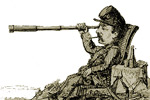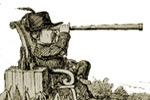

 Go Back |

|
 Signal Service |
|
The following information has been accumulated from various sources over time and is still on going as new information arises. It must be understood that before General Order number 36 in 1865 there was no one set of insignia utilized by the Signal Corps- Early war signalmen and officers wore no such designated insignia and were developed over time- speculatively due to the pride they took in the corps. These are the only known types of insignia used during the war (late war at that), living historians should take note of the “living historian” section at the end of this page. General Orders Number 36, Headquarters of the Signal Corps of August 22, 1864 reads: Description of Badge for Officers Hat and Cap: Same as for the other officers, with the following ornament: a gold embroidered wreath in front, on black velvet ground, encircling crossed signal flags, with lighted tourch, and supported by the letters "U.S." in silver in old English characters. Color of the flags: one red, with white centre; the other white, with red centre. Size of flag: three-eighths of an inch square; size of centre. one-eighth of an inch square; length staff, one and one-sixteenth inches.
Description of Badge for Enlisted Men Device on Arm: Crossed signal flags, red and white, on dark blue cloth Size of flags: Three-fourths of an inch square; centre, one-quarter of an inch square; length of staff, three inches. Sergeants will wear the designiation of the corps placed in the angle of the chevron upon the left sleeve, Privates will wear the designiaton of he corps in the same postion on the left sleeve as the chevron of sergeants. Officers did not wear the arm patches.
Requistion can be made upon this Bureau by Signal Officers in charge of detachments or sub-detachments of the corps for such number as may be required for their commands. These badges will be furnished by the manufacturer at the following prices: badges for officers, fifteen (15) dollars per dozen; badges for enlisted men, three (3) dollars per dozen. NCO/Enlistedman hat patch (Not in General Order) Resembling that of the Officers hat badge, many enlisted men received compliments as officers when not in full uniform because of the hat patch. This patch measured the same as the officers patch with a field of stars between the flags. Although not an "official badge" this patch seemed to worn by both NCO's and enlisted men alike.
Being that the corps was organized only as a provisional body and not as a permanent branch of the United States Army during the war. It was in direct competition with the Military Telegraph Service and does not appear to have enjoyed the full support of Secretary of War Stanton. That said, the activity of the Signal Corps during the war proved to be valuable enough to cause the Corps to become a permanent branch of service of the U.S. Army in 1866. During the Civil War officers were detailed to the Signal Corps from existing regiments. After attending a camp of instruction and passing an exam, they were appointed as acting signal officers. They remained on the rolls of their prior units as being on detached service. Originally the Corps functioned without Congressional authority, but was finally recognized by provision of an Act of Congress (Public Law No. 58 Article VIII, Section 17 and 18) approved on March 8, 1863. The Corps was authorized to have one sergeant and six privates for each officer. Notice that there were no corporals. The number of officers was to be one captain and no more than eight lieutenants for each army corps or department. The Chief Signal Officer was to be a colonel and he would be assisted by one lieutenant colonel and two majors, who would act as inspectors. In November 1864 there were 168 officers and 1350 men in the Signal Corps. Because of its status as a provisional branch, no branch color was officially mentioned in U.S. Army uniform regulations or appears to have been used during the war. On July 22, 1864 Major Nicodemus sent a request to the Adjutant General for general orders to be issued prescribing a uniform for the Signal Corps. Included in this request were unique Signal Corps buttons for both officers and enlisted men. This request was turned down with the exception of cloth insignia approved by the above orders and the Signal Corps would not have its own button until the 1880s. The crossed signal flags, worn by enlisted men were originally to be worn on the left arm, but in practice was worn on both sides. Officers' uniforms were similarly difficult to characterize. Albert Myer as the Army's Signal Officer wore the uniform of a staff major. Early signal officers appear fairly generic in photographs. They may have worn the uniform of their prior branch or that of a staff officer. The insignia authorized in 1864 may have been an effort to bring some uniformity to the Corps. |
|